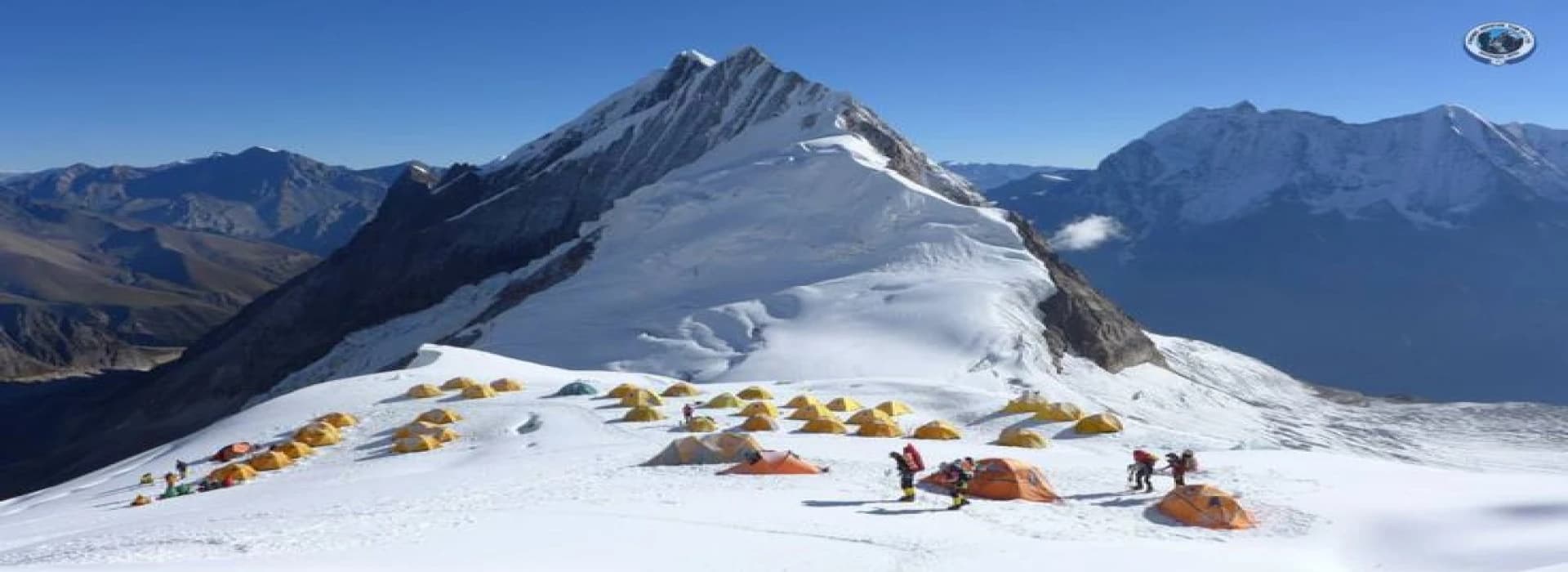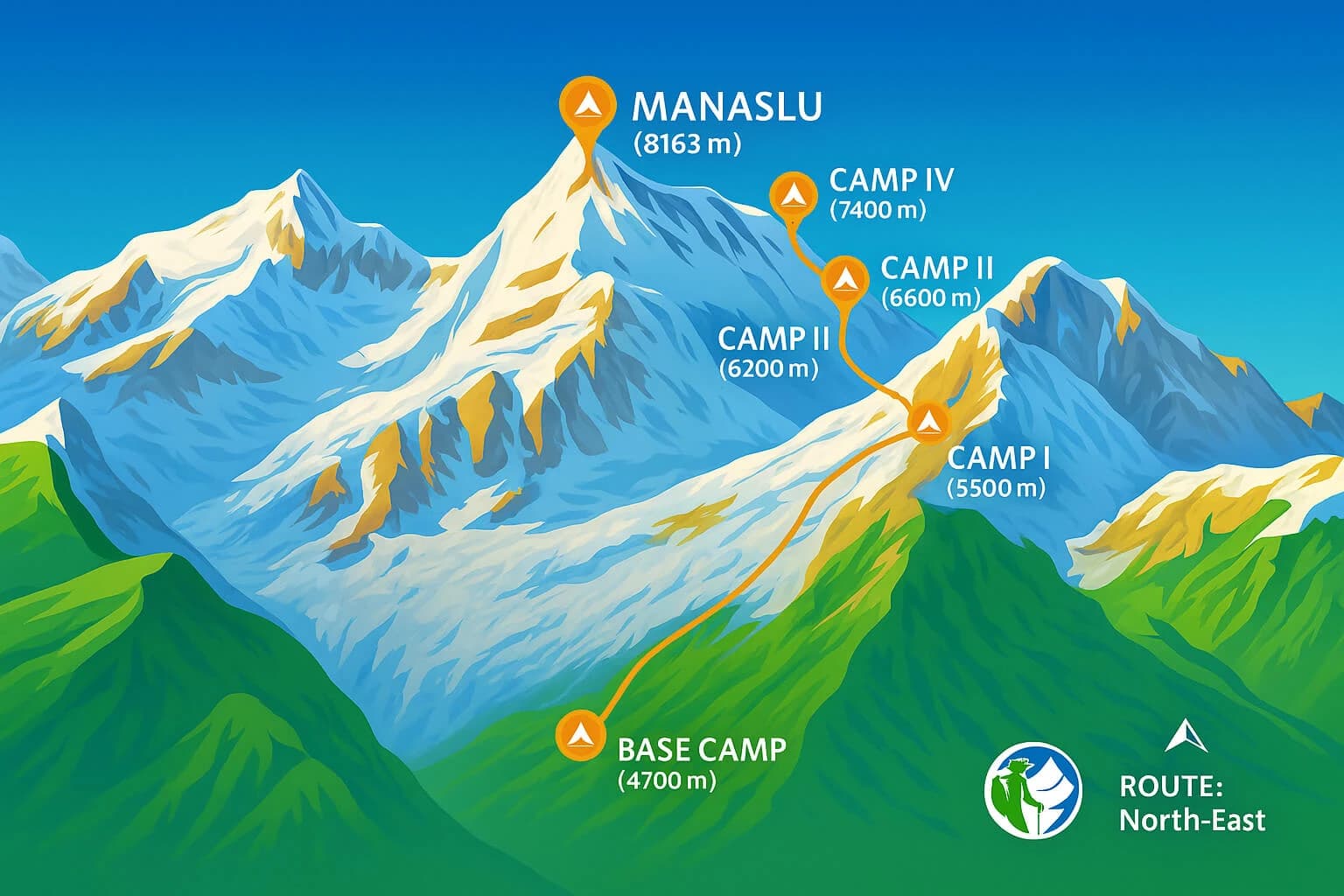We successfully summited Manaslu on 17 October 2023 with thanks to your terrific support and assistance from all of the
Manaslu Expedition Overview
The Manaslu Expedition 2026 is an exciting opportunity to climb the magnificent eight-thousander, Mount Manaslu (8,163 m / 26,763 ft), also known as the "Mountain of the Spirit." This climb is also popularized as the last stone before the ascend to Mount Everest.
Located in Nepal's Central-Western Himalayas, this gaint of Nepal is the eighth-highest mountain in the world and was first summited in 1956 by Toshio Imanishi and Gyalzen Norbu from Japan. The mountain journey will again take the historic Northeast Face route, which features advanced ice and snow slopes with stunning views of the Himalayas.
This magestic peak Expedition in Spring and Autumn of 2026 is intended for climbers who have previously completed ascents in the area of 6000 to 7000 meters.
They possibly have real mountaineering, and real, high-altitude ascents, riding, and withdrawing experience.
This is a real high-altitude himalayan summits with a technical route, but climbers will have a fixed rope line, with Sherpa support and a solid plan for acclimatization, and the type of building that we have already set up.
The route becomes a very physical climb, with long pitches, ice sections, traverses, and crossing crevasses. The overall requirements will assess your endurance and mountaineering skills.
The adventure starts with a scenic ride from Kathmandu to Soti Khola, and then continues with a Trek through the Budhi Gandaki Valley, beautiful forests, and isolated mountain villages to reach Sama Gaun, which is the entry point to Manaslu Base Camp.
Next, the subbmits and effort carry on through the ice slope and exposed ridge; the mountaineer is rewarded with spectacular panoramic views of Himalchuli, Ngadi Chuli, Saula, and other giant mountain peaks.
This eight highest mountain journey 2026 is a great option for those mountaineers who want to peak attempts Everest in the future- a tough yet attainable climb up into the death zone, offering adventure and challenge, skill enhancement, and excitement, while experiencing the monumental beauty of the Himalayas all in a single expedition.
Highlights
- Scale the mountain of Manaslu, the world’s 8th highest peak, at 8,163 m (26,781 ft) tall.
- Experience the stark and stunning beauty of this regioin.
- Hike through untouched village communities that offer visitors a glimpse into their rich Tibetan-Buddhist history and welcoming local hospitality.
- Travel through contrasting landscapes: lush subtropical forests, alpine meadows, and towering glaciers through high-altitude paths.
- Marvel at the breathtaking views of the Manaslu, Himalchuli, Ganesh Himal, and Langtang peaks.
- Cross the famous Larkya La Pass (5,160m) with views of the surrounding mountains.
- Visit ancient day monasteries and local village settlements like Samagaon and Dharamsala.
- Presented with an organized and sophisticated mountaineering trip- with knowledgeable Sherpa support and experienced guides.
- To enjoy low traffic with your trek for a unique off-the-beaten-path excursion.
- De-risking altitude sickness is a function of acclimatization experience scheduling.
- Capture photographs of some incredibly unique fauna and flora, like the rare snow leopards and blue sheep in Nepal.
- Have a chance to enjoy local homestays and authentic local cuisines to immerse yourself in the local culture.
- Experience fulfilling achievement of a classic high-altitude ascent in the Himalaya.
- The trip offers the right mix of adventure, culture, and beauty for hikers and serious mountaineers alike.
- With the high altitude journey fully supported, including permits, porters, and logistics, all were safely organized and planned.
Climbing The 8th Tallest Mountain in 2026
As of 2026, the experience of subbmite Nepal's giant is extremely exhilarating for climbers. The peak stands at 8163 meters (26,781 feet), providing comparable excitement to submits Everest and Annapurna, albeit less crowded.
The peak expidition season in 2026 is projected to be the anticipated window between late March and early June, and again between late September and November. The best weather windows are expected for both spring and fall months.
Price for an climb in 2026 is estimated to be around $12,000 per person and is generally inclusive of permits, fees charged by the governments, experienced sherpas, other staff, food, and accommodations during ascent.
Here are a couple of important points to remember about the climb in 2026:
- The fees for permits and paperwork are much lower than peak attempt over 8000m.
- There are stunning views on the himalayan journey, like the spectacular Larkya La Pass.
- Climbers should be in good shape and be prepared for possible extreme weather changes associated with high-altitude climbing.
Climbing Himalayan giant peak in Spring Window 2026
Joining this expedition in the Spring of 2026 will give climbers a great chance of trying Manaslu massif.
In general terms, the weather is usually less turbulent than during the monsoon season, and is generally not as severe as in the winter months.
March-May forms one of the best periods of the year to mountaineering an 8000 m peak. The light at that time is better, the temperatures are beginning to warm at the lower elevations, and storms are less frequent.
The route ascends the classic North-East ridge.
The climbers will be trekked into Base Camp through the Budhi Gandaki valley, and will then ascend through various high camps, fixed rope sections, crevasses, and steep snow slopes to the summit. The summit is 8163 m.
Climbing in Autumn Window 2026
The autumn submit conditions (usually from late September and ending by early October) are excellent on Manaslu. There is good weather and clear skies in the spring, so there will be less congestion on the mountain than in the fall, when climbing is busier than in the fall.
In 2026, you will have high-quality mountaineering with technical climbing on the first day and a luxury experience of the Himalaya.
You can expect steep slopes of snow and ice, fixed ropes, exposed ridges, a long ascent to the summit, and all the difficulties of an 8,000-meter peak.
This himalayan adventure is well-suited for those mountaineers with experience at 6,000–7,000 m who are training for the highest ascents.
Your experience begins with the scenic drive (or drive and trek!) from Kathmandu, and through the Budhi Gandaki valley to base camp.
Then you will ascend through several high camps, cross crevasses, navigate arêtes and fixed rope, and finally, summit the colossus at 8,163 m.
The autumn window provides the best chance for clear views and a safer climbing phase as you push into the "death zone".
Who is suitable for Expedition?
1. Experienced High-Altitude Climbers
The Manaslu expedition qualifies as advanced expidition. Although it is often labeled as one of the “easier” 8,000-meter mountains, the complete climb requires a high degree of previous alpine climbing experience; in particular, Mountaineering previous mountains above elevations of 4,000–7,000 m and a familiarity with glacier travel, fixed ropes, as well as ice axes and crampons.
Climb operators generally expect climbers to be capable of gliding between camps with little navigation assistance (what’s called “non-guided” climbing in alpine ascents) and tackling on difficult terrain as required.
2. Stamina - both physically and mentally
First, it is very important to be physically fit. The expedition involves long days, steep snow slopes (some of which are 50-60°), peak attempt in and out of crevasses, and long days, as a climber, over 6,000 m, where the oxygen is thin.
Mentally, the expedition will require endurance, patience (for acclimatization), and an ability to endure discomfort and risk (the cold, tiredness, storms) without quitting.
3. Familiar with Technical Alpine Skills
You need to be comfortable with:
Fixed line glacier crossings (ladder crossings, steep snow walls).
Gear: ice-axe, crampons, harness, jumars/ascenders.
High altitude movement with any self-carrying equipment, self.
4. Willing to Devote Time & Accept Risk
The entire journey is long (a minimum of a few weeks) and occurs in remote, high-altitude areas. You must accept that risks include altitude illnesses (AMS, HAPE, HACE), potential for avalanches or crevasses, and limited evacuation/rescue options in remote areas.
5. Willing to work in a team environment.
Although there is support to the climb (Sherpa expidition teams, fixed ropes, etc.), participants must be prepared to operate as a member of a alpine ascents team and be self-sufficient in many respects.
Understanding the Manaslu High Camps: Camp I, II, III (IV) Setup-
Camp I (≈ 5,600‑5,700 m)
Altitude: around 5,600–5,700 metres above sea level.
Terrain/what to expect: Terrain/what to expect: iconic uphill path from base camp; moraine terrain and glacier cross (crevassed glacier) to reach Camp I.
Purpose: Camp I is the first high camp located above base camp. Climbers will begin to feel the thinner air, the weight of packs, and concerns about terrain.
Camp II (approximately 6,300-6,400 m)
Altitude: Approximately 6,300 - 6,400 m
Surface / Technical section: After you leave Camp I, your ascent on the route to Camp II will be rather moderate-angle snow slopes, plus a small (not overly large but reasonably distinguished) steeper section located immediately above Camp I.
This is what is now referred to as a lower oxygen state. This is the timeframe where your body is working a little and receiving less oxygen.
What to expect: A more tiring ascent (taking 5-7 hours on the conditions) with more risk of an altitude effect, requiring appropriate concentration and pacing.
Camp III (≈ 6,900 m) and Camp IV (≈ 7,300 m)
Altitude: Camp III is about ~6,900 m, and Camp IV is roughly ~7,300 m.
Terrain/"death zone" phase: The two camps exist in what is often referred to with phrases like "high altitude" or "near death zone" terrain, where the oxygen is considerably low and the mountain adventure becomes serious. From Camp III to Camp IV, the route has some steep verticality. Fixed ropes and crampons will be utilized leading to this camp.
What to expect: An extreme ascent placed in a risky altitude zone with fatigue and in a technical context. From camp III or IV, you will then launch a summit push.


